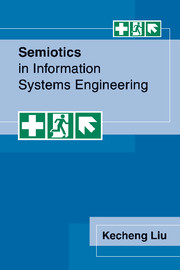Book contents
- Frontmatter
- Contents
- Preface
- 1 Introduction
- Part one Semiotic framework and methods
- Part two Applications
- 9 From semiotic analysis to systems design
- 10 Semantic temporal databases
- 11 Normbase: a new approach to information management
- 12 Case study: development of a land resources information system
- 13 Case study: development of a test construction system
- Appendix A Semantic templates and surrogate specification
- Appendix B LEGOL applications in the CRIS case
- Bibliography
- Index
11 - Normbase: a new approach to information management
Published online by Cambridge University Press: 19 September 2009
- Frontmatter
- Contents
- Preface
- 1 Introduction
- Part one Semiotic framework and methods
- Part two Applications
- 9 From semiotic analysis to systems design
- 10 Semantic temporal databases
- 11 Normbase: a new approach to information management
- 12 Case study: development of a land resources information system
- 13 Case study: development of a test construction system
- Appendix A Semantic templates and surrogate specification
- Appendix B LEGOL applications in the CRIS case
- Bibliography
- Index
Summary
Normbase is not just a software system. It represents a new way of managing information. It also represents a new approach to the development of information systems using semiotic methods. The chapter will introduce the concept of Normbase, and the Normbase system as a software environment for managing information. It will also discuss how the Normbase system can be used for supporting business management and decision-making.
The Normbases concept
Norms are parts of business knowledge that determine the meanings of the data in databases. The knowledge serves as a constraint upon the organisation and utilisation of the data. In order to allow only meaningful interpretations of and operations on the data, the knowledge must be consolidated into the technical information systems in a proper way.
The database discipline has established an approach to incorporating business knowledge into the technical information systems following the principle of data independence. Data independence, as one of the objects of database systems, provides an important separation between data and applications. It furnishes an immunity of application programs from changes of the data storage structure and access strategy (Date 1995). Data independence is achieved by isolating the domain-specific (knowledge) parts of the database system from the general (supporting) part. This process of knowledge abstraction can be applied not only to databases, but also to programming techniques. In object-oriented programming languages, the technique of abstract data types allows one to specify certain operations on a data type without having to affect the internal representation of the instances.
- Type
- Chapter
- Information
- Semiotics in Information Systems Engineering , pp. 150 - 163Publisher: Cambridge University PressPrint publication year: 2000



